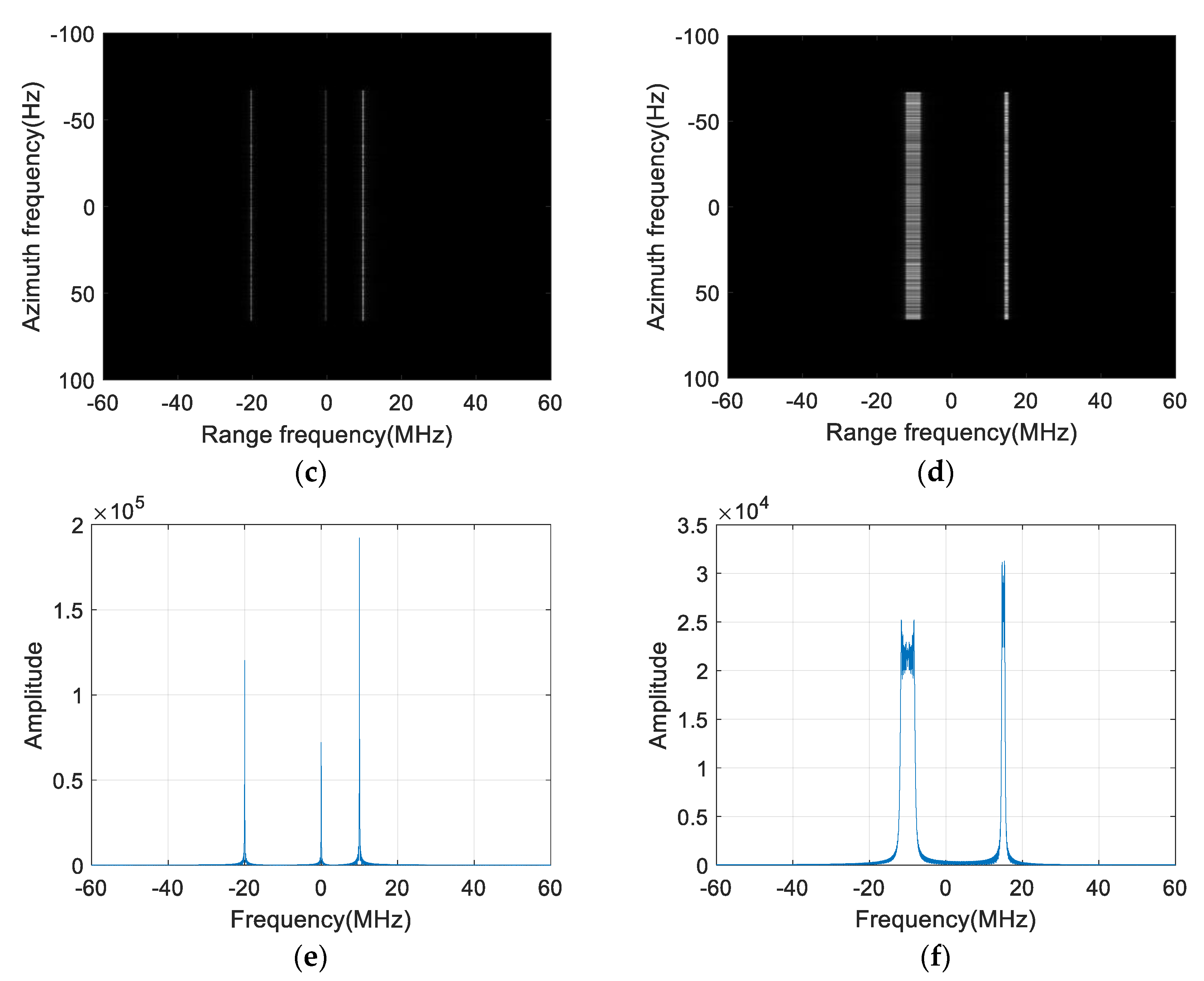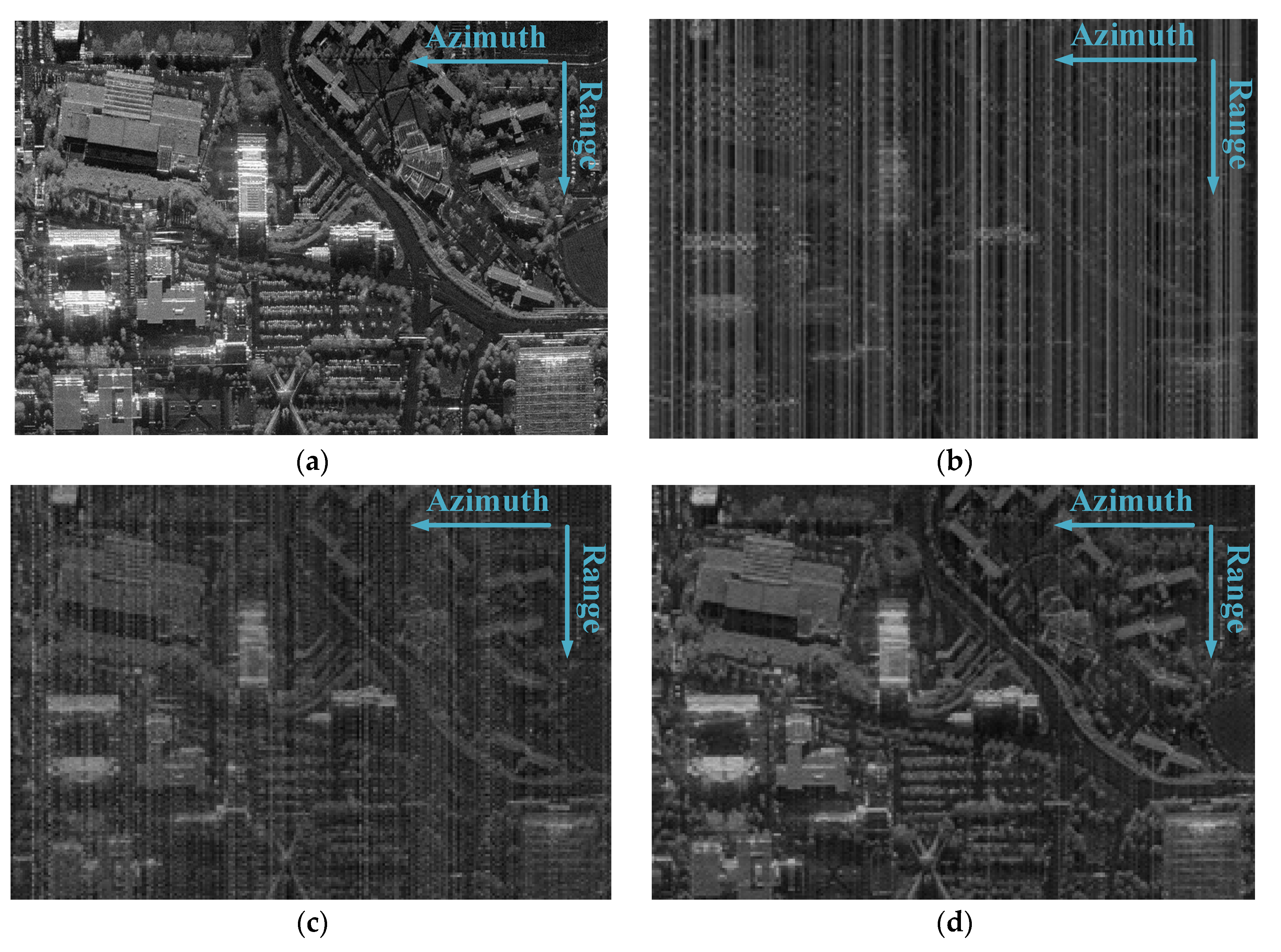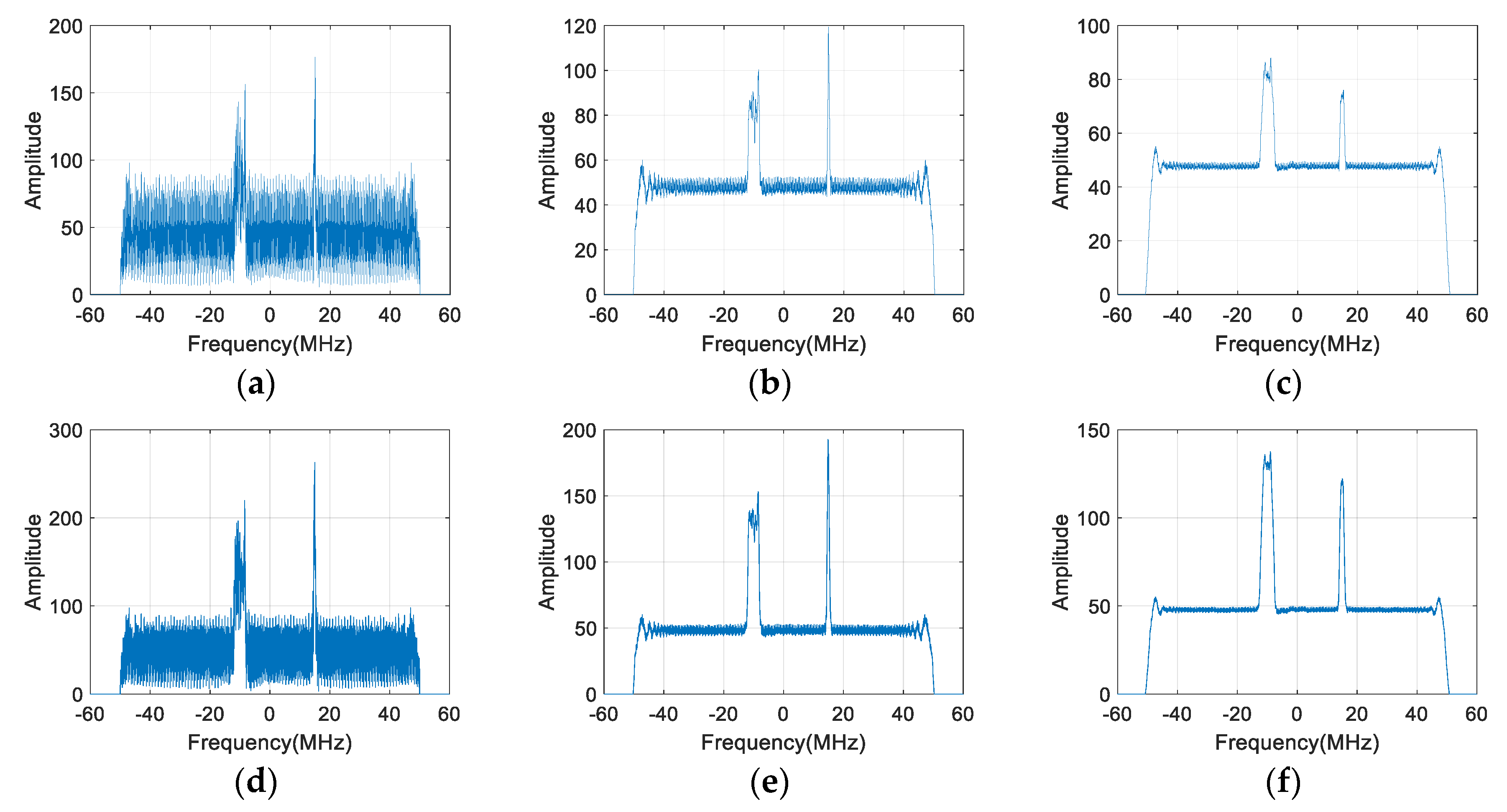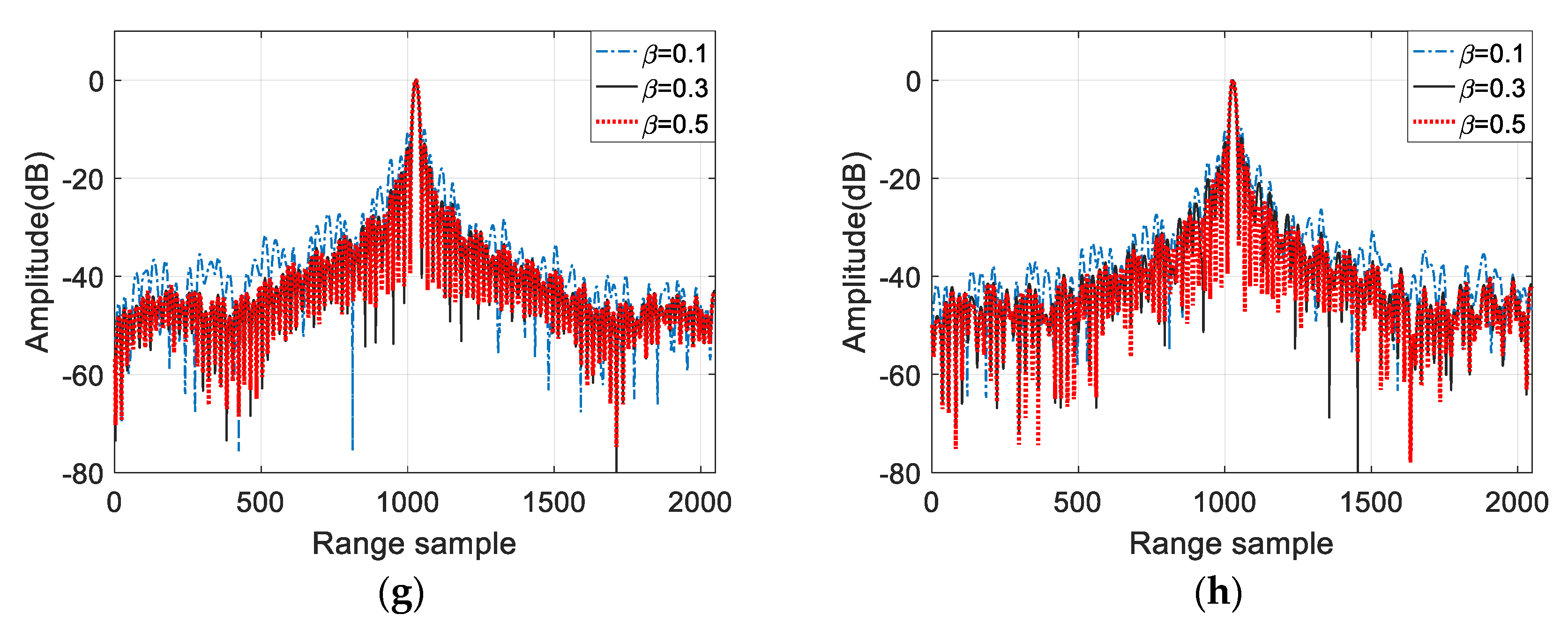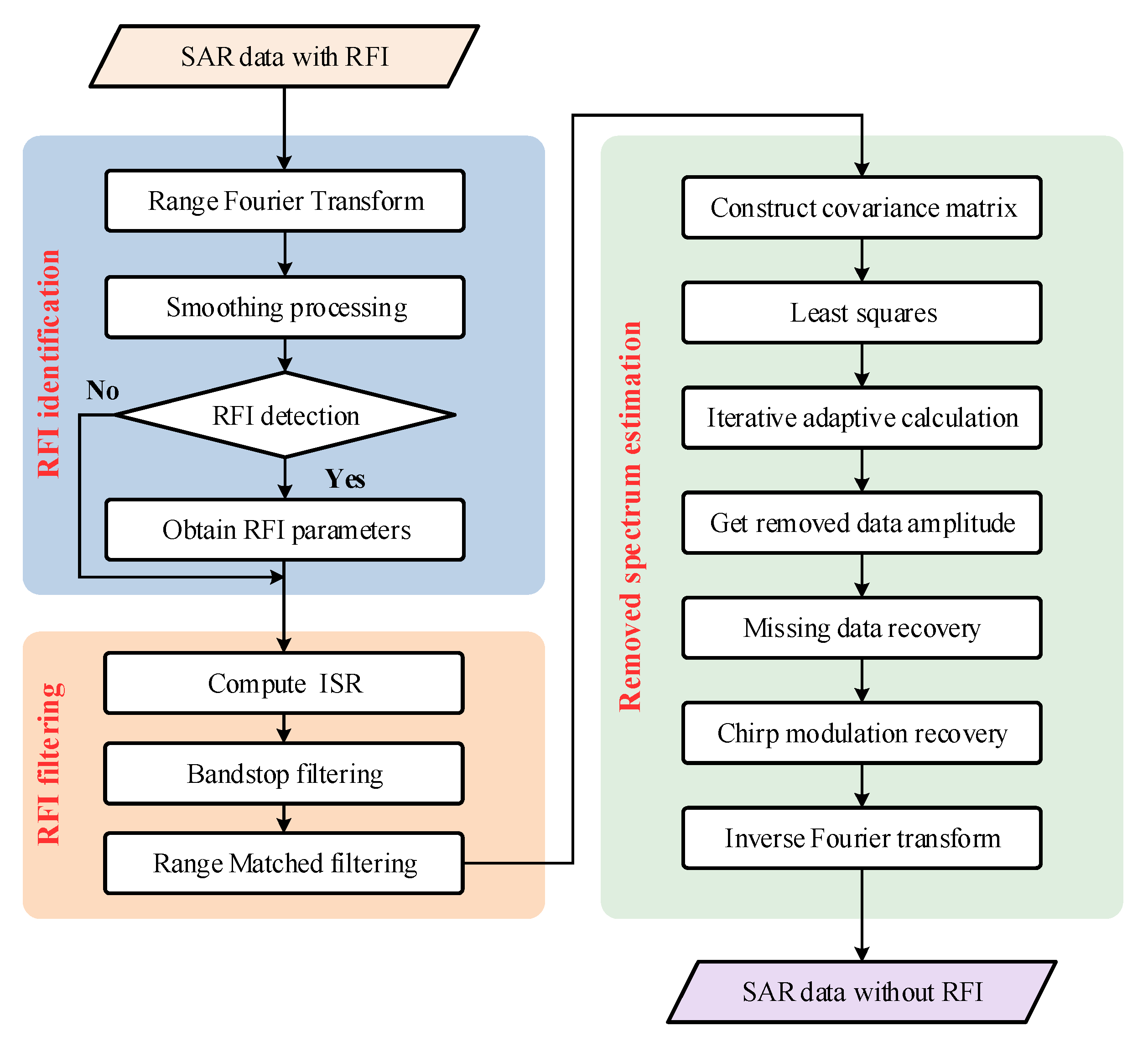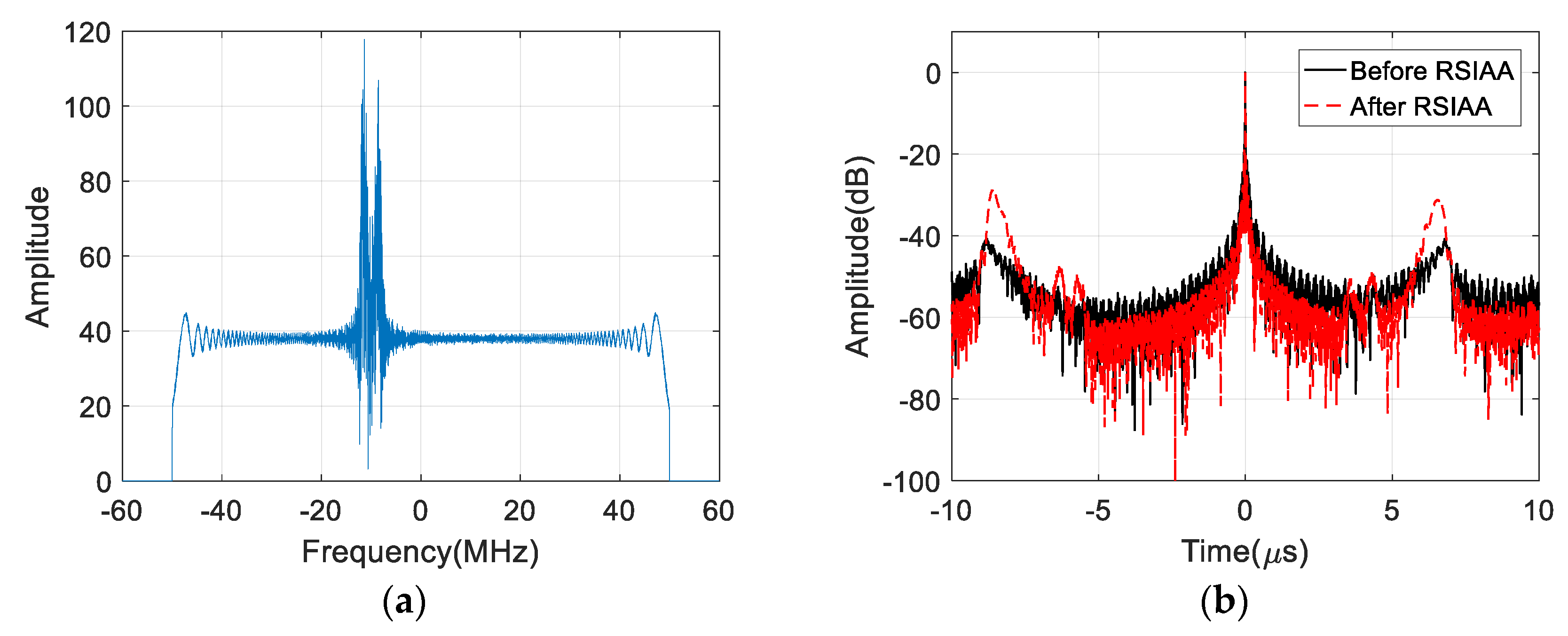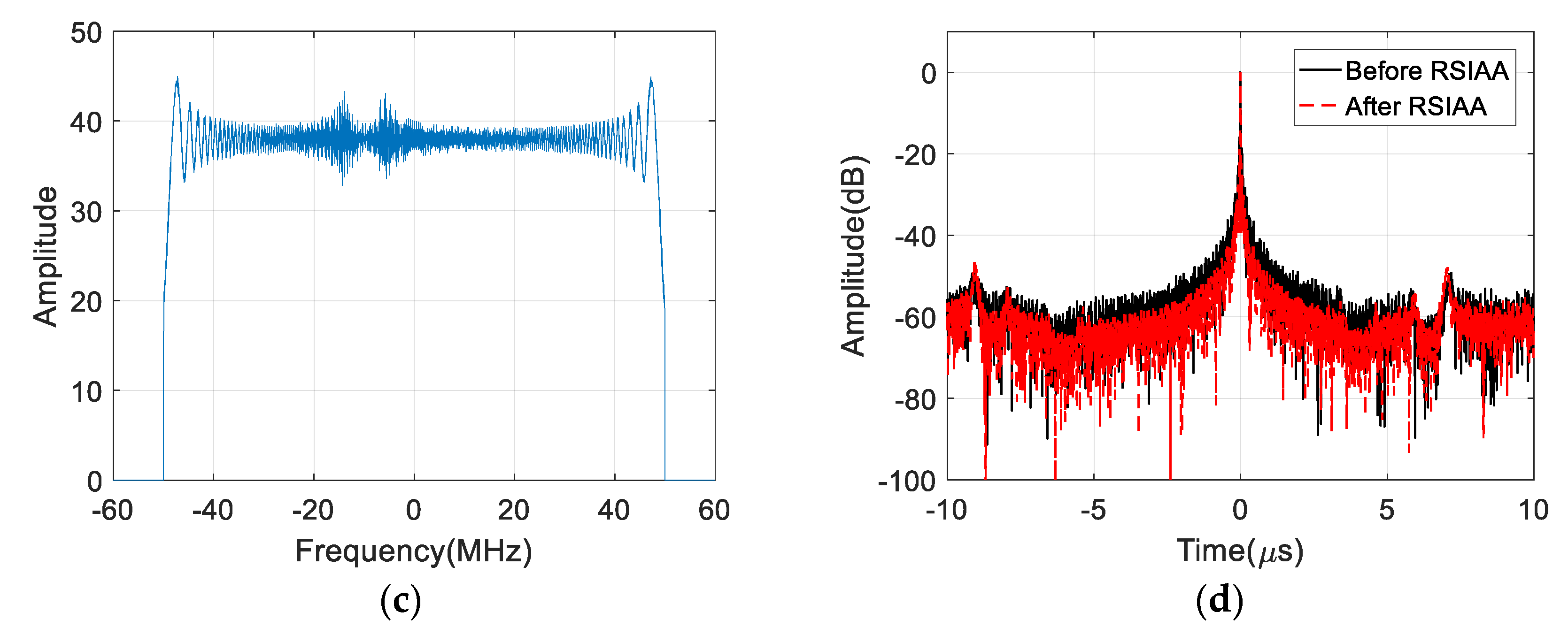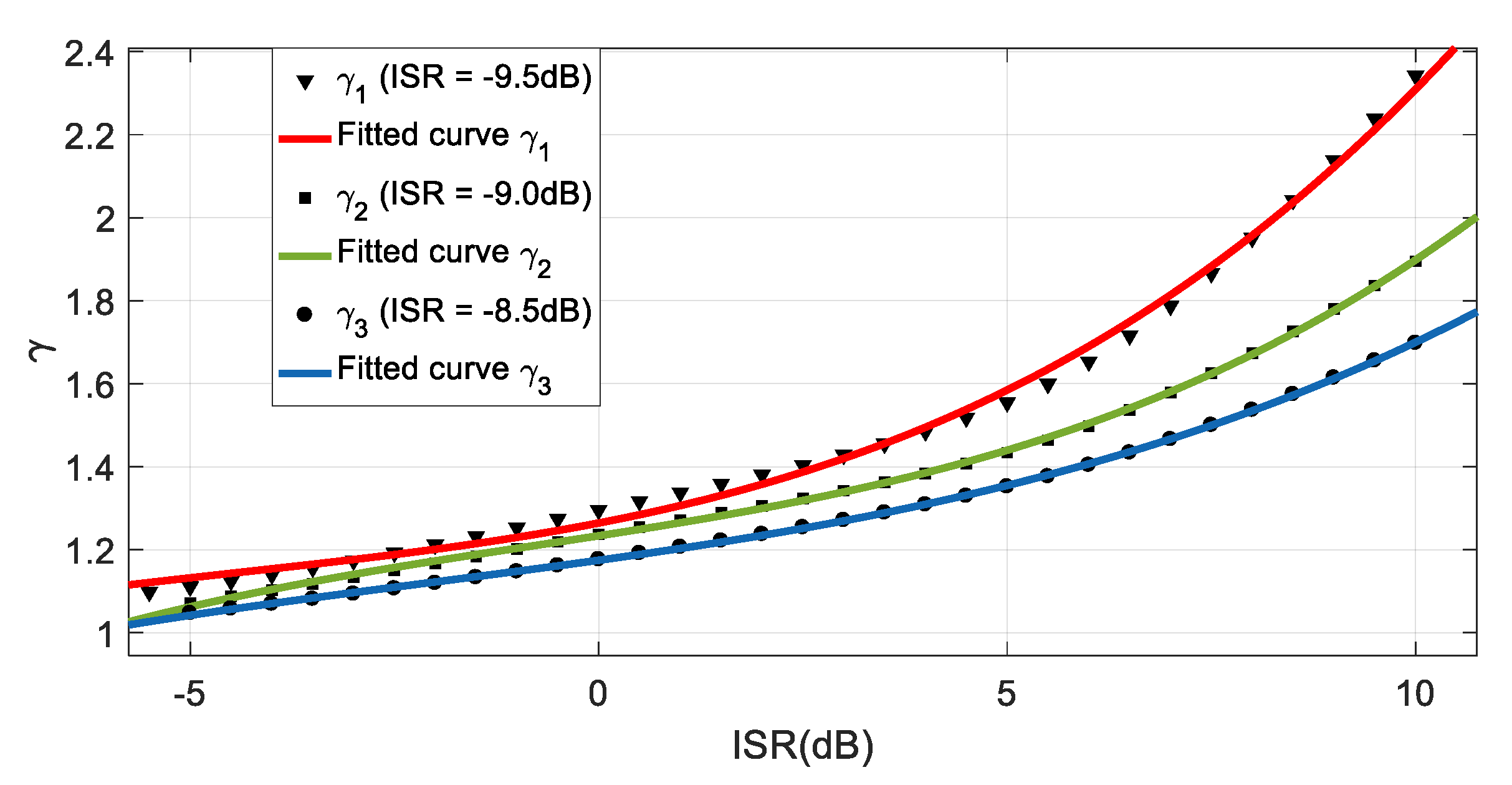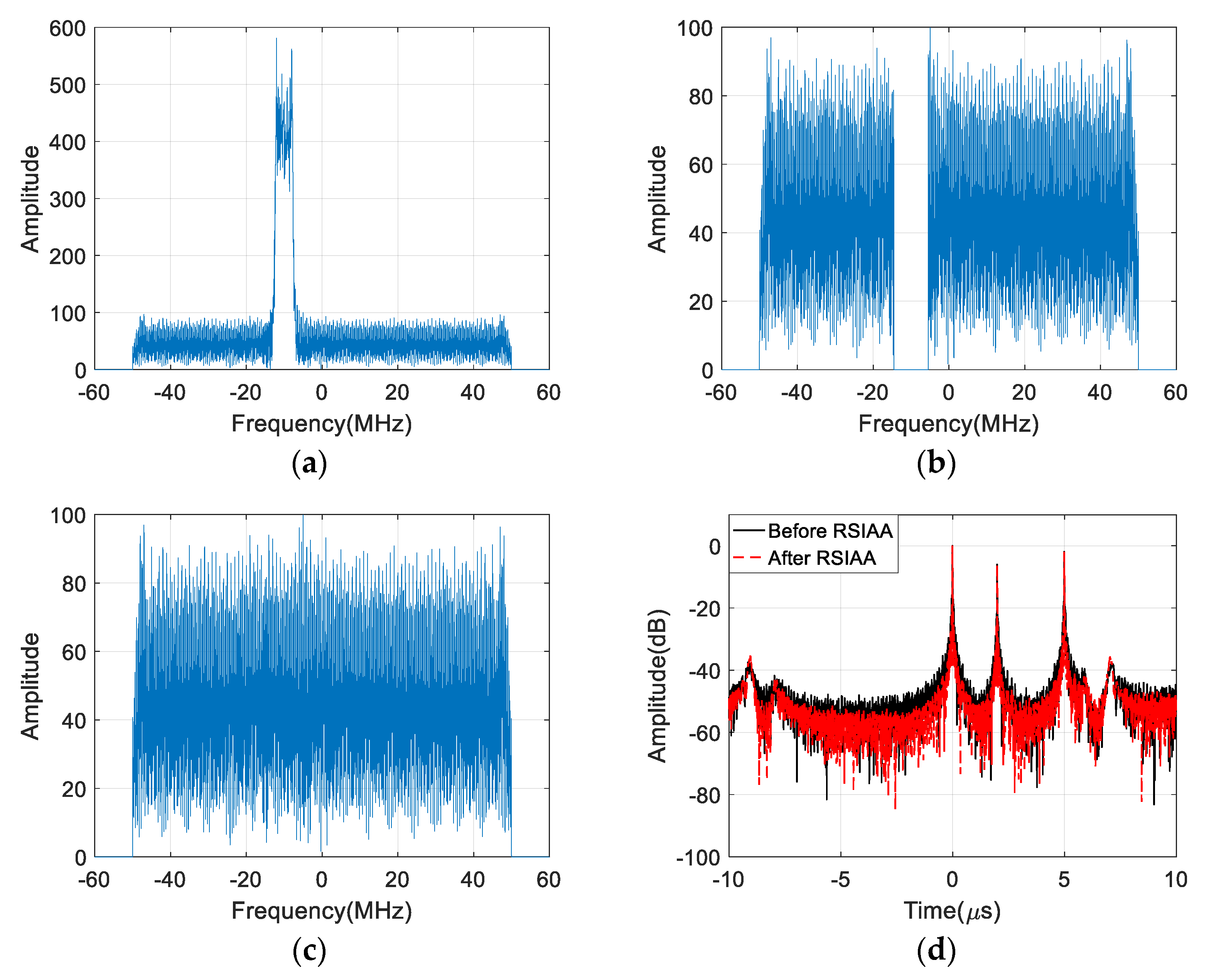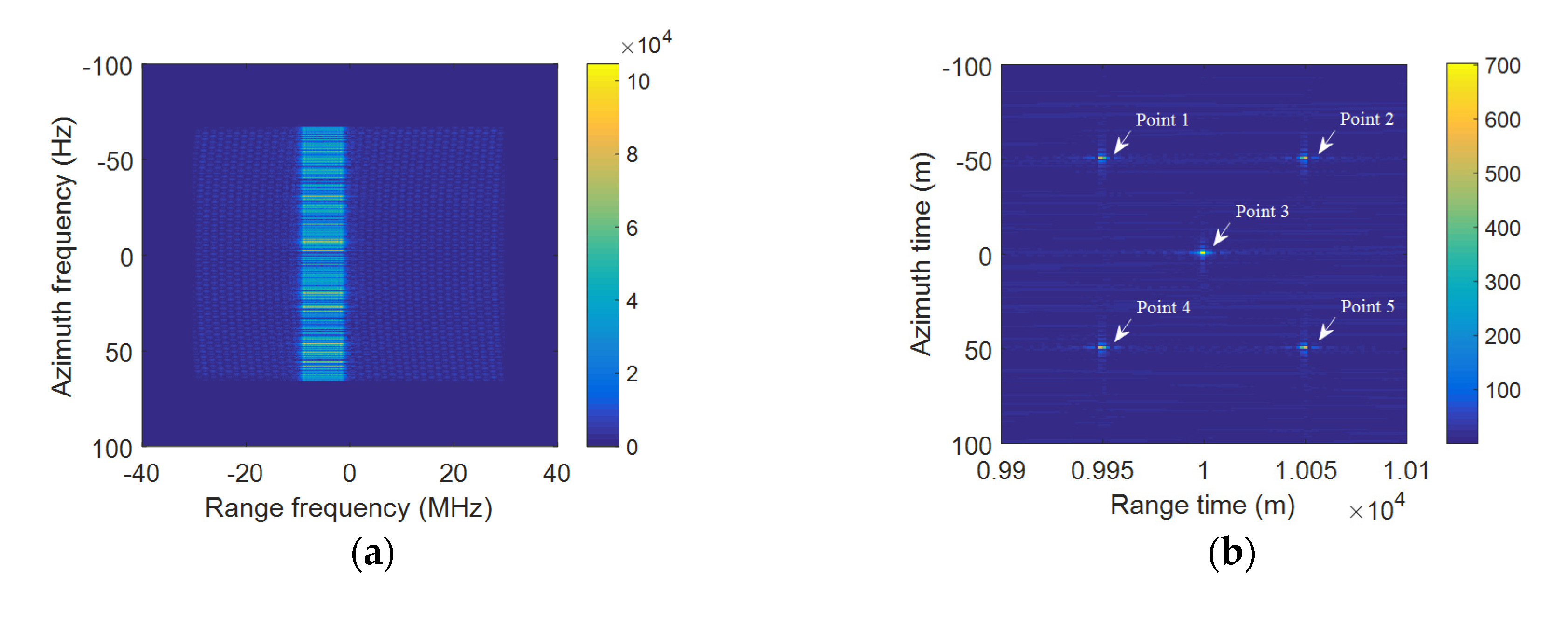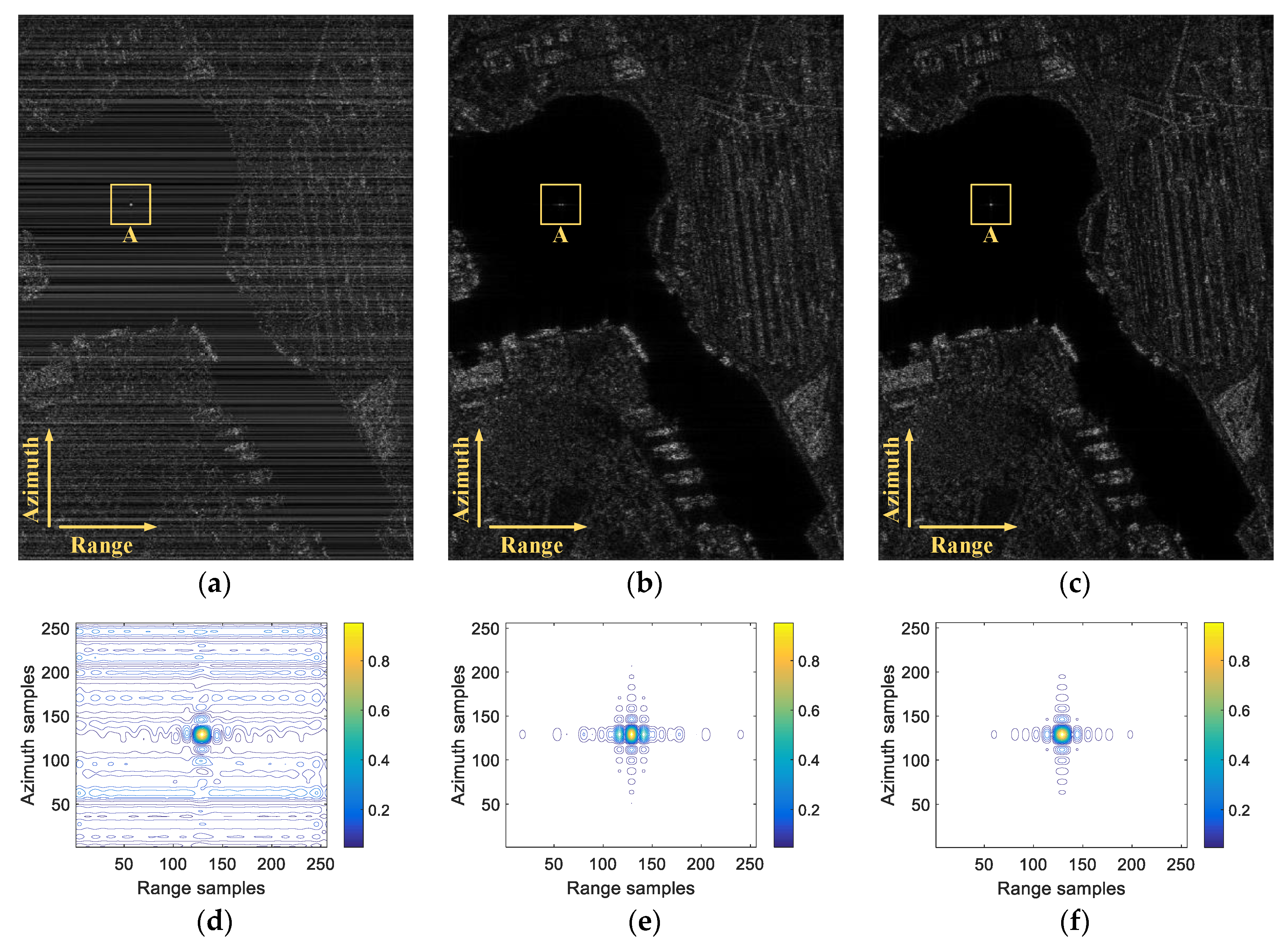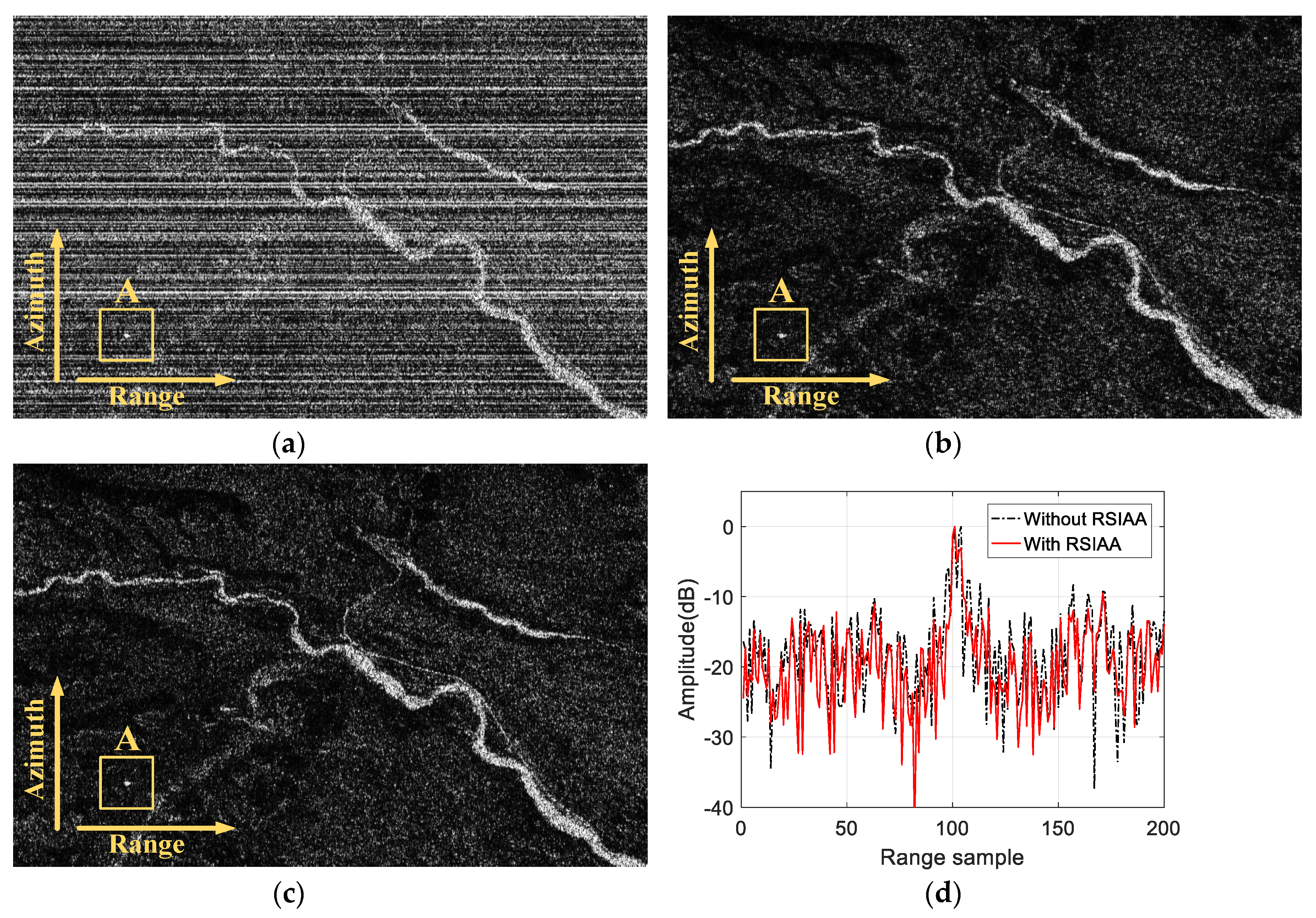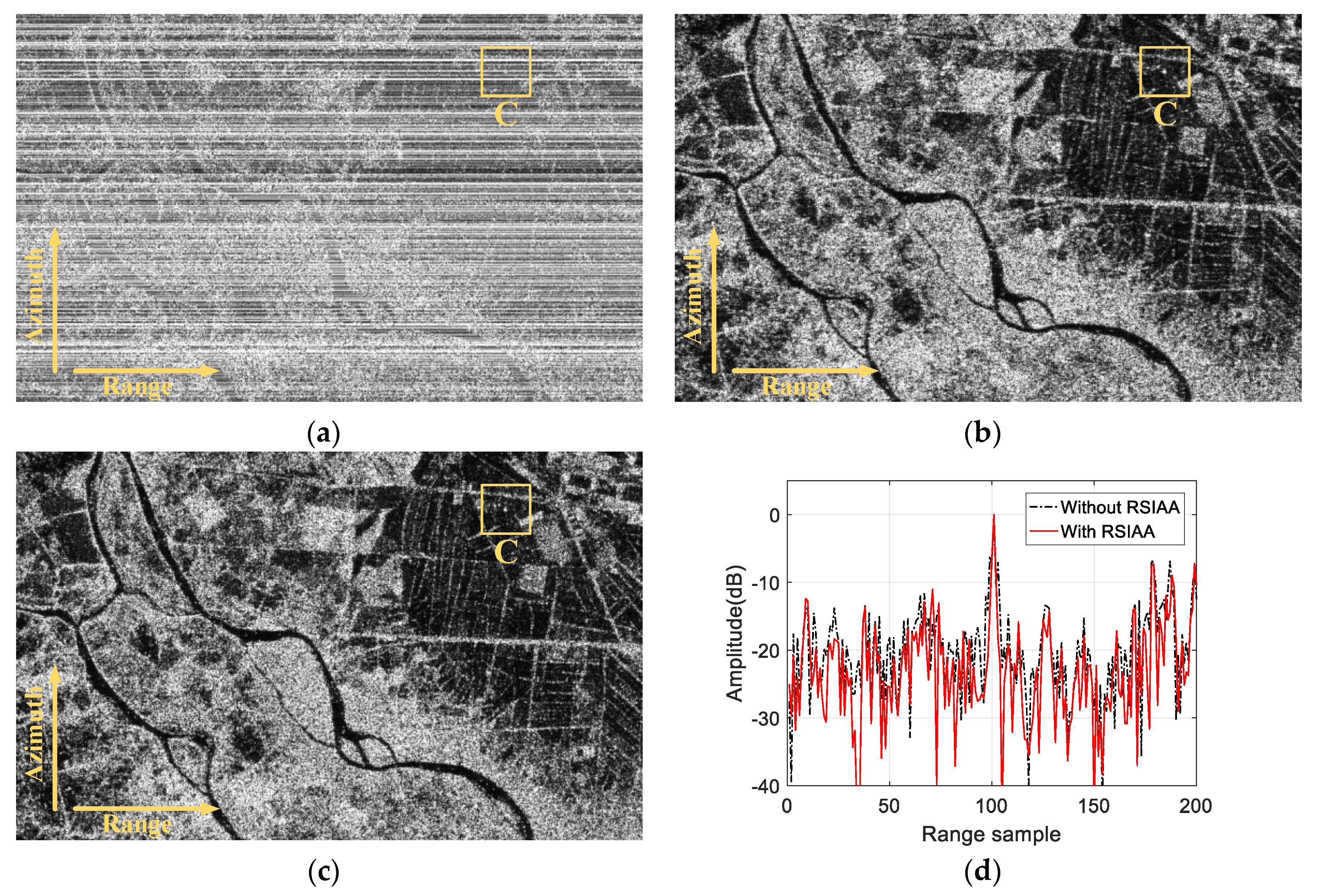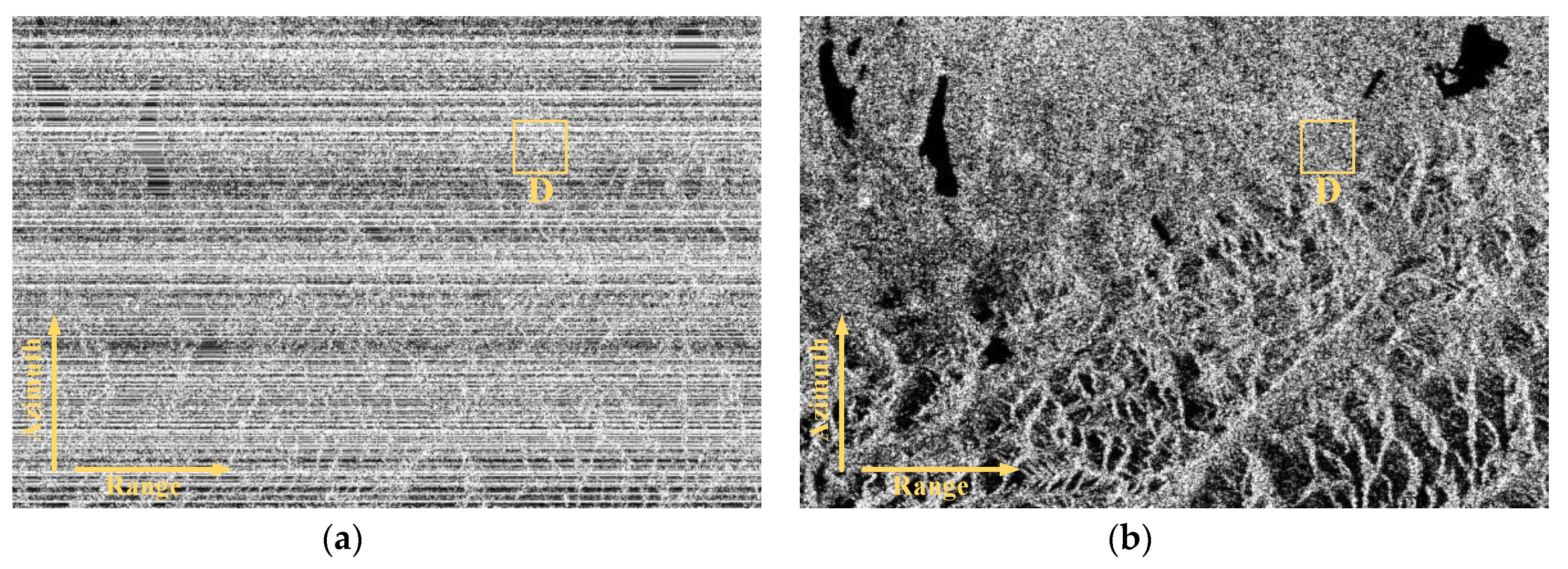1. Introduction
Synthetic aperture radar (SAR) is an active microwave remote sensing instrument for Earth’s surface observation, and it can be widely utilized in both military surveillance and civilian exploration [
1]. However, in the more and more complex electromagnetic environment, the received SAR echoes are increasingly corrupted by radio frequency interferences (RFIs). Although SAR systems have an inherent capability of anti-interference, RFI signals with characteristics of a one-way propagation path and long working time can severely degrade the quality of the desired SAR images [
2,
3,
4]. Commonly, typical RFI resources mainly come from networks, communication systems and other electromagnetic devices [
5,
6,
7]. Hence, radio interference identification and suppression have attracted extensive attention in the SAR field.
According to the interference bandwidth to the SAR signal bandwidth ratio, RFI can be simply divided into narrow-band interference (NBI) and wide-band interference (WBI). The bandwidth of NBI is usually tens of kilohertz, while the WBI bandwidth is usually less than 10 MHz and much smaller than that of wideband SAR systems [
8].
In recent years, RFI suppression approaches have been mainly categorized into two classes: parametric and nonparametric methods. In terms of the parametric approaches, the interferences are constructed as a sinusoidal model [
9,
10,
11], and its amplitude, frequency and phase is estimated by the least mean square method [
12,
13,
14] or the maximum likelihood approach [
15]. The mathematical model is optimized under specific criteria [
16,
17,
18,
19], and the RFI can be extracted and subtracted from the received SAR echo signals. Commonly, the NBI is suppressed using the parametric methods because of the multiple generated sinc peaks in the frequency domain. Yi et al. [
17] and Guo et al. [
18] proposed an effective approach using the maximum a posterior (MAP) estimation for RFI suppression, but the approach depends on the precise prior knowledge. The RELAX algorithm is a signal parameter estimation method which estimates the target signal parameters by minimizing the nonlinear least square method, and this method can be used to estimate the RFI parameters. Huang et al. [
11] proposed a gradual use of the RELAX algorithm, which can estimate the parameters for each frequency peak with a reduced number of estimation iterations of the traditional RELAX algorithm. Although parametric methods can accurately estimate the sinusoid model, these methods are restricted by some conditions, such as prior knowledge, computational complexity and precise model [
20,
21]. Unlike the parametric methods, the nonparametric methods implement RFI suppression without any prior knowledge or precise model, and the spectral characteristic is exploited to filter out RFI in the frequency or time–frequency domain. The NBI and WBI are mitigated by nonparametric methods based on the designed filters and constructed subspace projector. In [
22], Zhou et al. proposed an eigenvalue subspace projection (ESP) method that constructs the NBI and signal subspaces by singular value decomposition (SVD) to suppress the interferences. The least mean square (LMS) filter was designed by Le et al. to adaptively mitigate interferences for single-channel SAR systems [
23]. The band-stop filtering method is a typical nonparametric method, which designs a frequency notching filter to remove the interference that occupies a certain frequency band [
24,
25]. However, the interference is effectively suppressed by the band-stop filter, while the useful signal in the same frequency band is also removed, which results in multiple artifacts in the final SAR image.
In this paper, a novel RFI suppression method including RFI identification, frequency band-stop filtering and the removed spectrum iterative adaptive approach (RSIAA) is proposed. Firstly, the spectrum smoothing preprocess, which uses a sliding averaging window to reduce the spectrum dynamic range, is added to the conventional RFI detection in the frequency domain to ensure accurate RFI detection and identification. According to identified frequency parameters of detected RFI signals, the RFI signals can be removed by the designed band-stop filter. Taking account of the Gibbs effect in the digital Fourier transform (DFT), the small amount of residual RFI energy would not only affect the quality of the final SAR image but also degrade the accuracy of the following removed effective spectrum recovery. Hence, the bandwidth broadening factor for residual RFI energy mitigation is analyzed and designed. Then, the band-stop filter is conducted based on identified RFI frequency parameters and the bandwidth broadening factor. Unfortunately, part of the useful spectrum in the same frequency band is simultaneously removed with RFI signals, which will degrade the SAR image quality and is the major disadvantage of the band-stop filtering method. The iterative adaptive approach (IAA) [
26] is an effective method for missing data amplitude estimation, and when it is introduced to recover the removed effective range spectrum it is named as the RSIAA. Finally, the removed spectrum amplitude is estimated by a weighted least squares criterion, and the missing data amplitude is reconstructed from the adjacent spectrum data. After that, the RFI energy is effectively mitigated by the band-stop filter, and the range spectrum is still consistent. The advantages of the proposed approach can be summarized in three aspects: (1) the more accurate weak RFI detection capacity after the spectrum smoothing process; (2) the better residual RFI suppression effect due to the introduced broadening factor; (3) the improved SAR image quality after the removed spectrum estimation by the IAA. Furthermore, since all these processing operations could be implemented by a pulse-by-pulse behavior, another important advantage of the proposed approach is the effectiveness to deal with the azimuth time-variant RFI signals.
The remainder of this paper is arranged as follows. In
Section 2, the model of the interference signal is introduced, and the characteristics of different interferences are analyzed in the time and frequency domains. The RFI identification and removed spectrum recovery are presented in detail in
Section 3. In
Section 4, the proposed RFI suppression approach including RFI identification, band-stop filtering with a broadening factor and the RSIAA are described. Simulation experiments on simulated targets and real SAR data are carried out to validate the proposed approach in
Section 5. Finally, this paper is discussed and concluded in
Section 6 and
Section 7.
For clarity, the main abbreviations used in this paper are listed in
Table 1.
2. Interference Formulation and Analysis
With the increase in modern electromagnetic devices and the overlapping utilization of the electromagnetic spectrum, the SAR system with a wide frequency bandwidth is severely affected by the interference of other electromagnetic radiation sources in the working frequency band and, in particular, the SAR signal is susceptible to complicated interferences, including NBIs and WBIs in practical scenarios.
For a single-channel SAR system, each echo received during a pulse repetition time can be formulated as
where
denotes the range time sample,
denotes the complex-valued radar pulse,
indicates the desired target echoes,
and
are the RFI and additive noise, respectively. To generate an azimuth high-resolution SAR image, the received SAR signal is usually constructed into a two-dimensional (2D) time domain. Afterwards, the SAR signal in the range time
and azimuth time
is written as follows:
According to the narrow-band characteristics of RFI, it is assumed that the RFI signal is a superposition of a plurality of complex sinusoids [
27], and the mathematical expression of narrow-bandwidth RFI is defined as
where
Al is the amplitude envelope of the
l-th RFI signal,
fl and
ϕl indicate the carrier frequency and the modulated phase of the
l-th interference signal, respectively, and
L is the number of RFI signals. There are usually two ways to modulate WBI signals. One is the chirp-modulated (CM) WBI, the other is the sinusoidal-modulated (SM) WBI [
28,
29]. These two forms can be expressed as
where
is the amplitude envelope of the
l-th RFI signal,
and
represent the carrier frequency and the chirp modulation rate, respectively,
and
are the modulation factor and the phase of the
l-th interference component, respectively.
The received echoes are the superposition of echoes from multiple scatterings in the imaged scene, which makes the waveform of the received echoes disorganized in the range time domain. Hence, it is impossible to determine whether there is an RFI signal or not through the waveform of the time domain. Furthermore, since the bandwidth of the RFI signal is usually in the range of 0.1–10 MHz, the frequency bandwidth of the RFI signal is much smaller than the transmitted pulse bandwidth by SAR systems. The RFI detection is implemented in the frequency domain, and the received SAR data are transformed into the range–frequency azimuth time domain by the Fourier transform as:
where
is the range frequency,
is the number of samples and
,
,
and
denote the received echoes, NBI, WBI and additive noise, respectively.
According to simulation parameters of RFI signals listed in
Table 2,
Figure 1 shows illustrations of the NBI and WBI signals in different domains. In
Figure 1a,b, both NBIs and WBIs are presented as bright lines along the range direction in the 2D time domain after SAR imaging process. If these bright lines are superimposed on an SAR image, there is no doubt that they will hinder the SAR image interpretation.
Figure 1c shows the range spectrum of the NBI in the 2D frequency domain, which demonstrates that the NBI energy mainly concentrates on a few particular frequencies, and
Figure 1d shows that the WBI occupies a large proportion of bandwidth. Since the RFI signal has characteristics of the one-way propagation path, long working time and narrow bandwidth, it has high power in the range frequency domain, as show in
Figure 1e,f. Because of the Gibbs effect, the residual RFI may still exist after the conventional band-stop RFI suppression.
In order to analyze the influence of different intensities of RFI on SAR images, a focused SAR image of a city background is selected from a website [
30]. Different interference to signal ratios (ISRs) are intentionally added to the simulated raw data of the city SAR image, and the imaging results are shown in
Figure 2. Since the low-frequency band, such as L and P bands, is a common frequency band for both SAR and radio frequency systems, SAR signals in the low-frequency band are susceptible to RFI signals. Therefore, the L band is adopted in the following simulations [
2,
8], and the simulated RFI parameters are listed in
Table 2.
Figure 2a is the imaging result without any RFI signals for comparison, while
Figure 2b–d shows imaging results of the SAR raw data with RFI signals at different intensities. The strong RFI is added in
Figure 2b, and the high ISR is 10 dB and makes the whole SAR image unrecognizable.
Figure 2c has the ISR of 5 dB, in which the RFI will obviously affect target identification, especially weak targets. The ISR in
Figure 2d is 5 dB, in which the RFI may be considered well mitigated, but the small amount of residual RFI energy would result in some blurred stripes in the SAR image, especially for the areas with the low signal to noise ratio (SNR) level. The low ISR will not seriously affect SAR image applications for target identification, but it will degrade the accuracy of the detailed information description and extraction in SAR images, such as road extraction, building height estimation and detailed target information description.
4. Methodology
According to the abovementioned analysis and simulation results, the RFI suppression approach based on the RSIAA is proposed, which includes three major processing steps: RFI identification, RFI band-stop filtering and removed spectrum estimation. The flow chart of the proposed approach is shown in
Figure 5.
According to simulation results in
Figure 3, after smoothing processing via a moving average window, the dynamic range of the range spectrum is obviously reduced, and the RFI detection and parameter estimation including bandwidth and carrier frequency could be more accurately implemented. If the bandwidth of the band-stop filter is set to the detected bandwidth, the residual RFI energy due to the Gibbs effect will still degrade the image quality. Furthermore, the residual RFI energy will affect the following missing spectrum recovery by the IAA. Therefore, the band-stop filtering for RFI mitigation must have a broadened bandwidth.
The broadening factor
is defined as the ratio of the bandwidth of the band-stop filter to the one of the detected RFI bandwidth. To discuss the value of the broadening factor
, a simulation experiment on the point target is carried out.
Figure 6 shows the removed spectrum estimation and range compression results with different broadening factors, and factor
in
Figure 6a,c are selected as 1 and 2, respectively. It can be seen that the residual RFI energy due to the Gibbs effect would obviously affect the removed spectrum recovery, and the recovered spectrum in
Figure 6a results in high-level artifacts. After introducing the broadening factor
, the removed spectrum is recovered well, and then the high-level sidelobes caused by the discontinuous range spectrum are obviously suppressed, as shown in
Figure 6d.
Moreover, imaging performances including resolution (Res.), PSLR and ISLR after the RSIAA with different broadening factors are measured and summarized in
Table 5. According to the measured parameters listed in
Table 5, PSLR and resolution are almost the same, but ISLR is significantly affected by the broadening factor. Commonly, the high ISLR level would lead to an increased noisy background in the focused SAR image.
The relationship between the broadening factor
and the ISLR under different ISRs is shown in
Figure 7. Ideally, the ISLR of the pulse compression result with rectangular weighting is about 10 dB. The high ISLR level is not tolerated in multiple SAR image applications. Therefore, only a very limited ISLR increase is permitted, and the referenced broadening factor could be obtained according to the acceptable ISLR level. According to
Figure 7b, the minimum broadening factors for different ISLRs under different ISRs can be obtained. After taking interpolation and quadratic curve fitting as shown in
Figure 8, the referenced broadening factor is obtained as:
when
denotes the ISR, and it can be calculated from the echoes after RFI detection [
28]. For different referenced ISLR values, the coefficients
,
and
are obtained from quadratic curve fitting and listed in
Table 6. In addition, the used broadening factor can be a little larger than the referenced value in practice, but one that is too large will consume more computational resources and time.
Consequently, the proposed approach can be completely carried out to suppress RFI. First, the RFI identification after smoothing is used to obtain the interference bandwidth and carrier frequency. According to the measured ISR, Equation (21) and coefficients listed in
Table 6, the referenced broadening factor for RFI band-stop filtering can be obtained, and then the RFI signals could be well mitigated. Finally, the removed range spectrum is recovered by the abovementioned RSIAA, and then the range spectrum is still consistent.
7. Conclusions
In this paper, a nonparametric interference suppression approach based on the RSIAA is proposed, which is combined with RFI identification and band-stop filtering. Since the small amount of residual RFI energy due to the Gibbs phenomenon in DFT will still affect the SAR image quality and decrease the accuracy of the RSIAA, a broadening factor, which is related to the ISR level and tolerance limits of the SAR image quality degradation, is introduced for range spectrum band-stop filtering. The major disadvantage of band-stop filtering for RFI mitigation is part of the effective range spectrum of the desired echoes is simultaneously removed with RFI signals. Compared with the bandwidth of the SAR system, the bandwidth of band-stop filtering is relatively limited, but it would still result in the increased sidelobes and artifacts in the range direction and obviously degrade the SAR image quality. Consequently, the iterative adaptive approach for removed spectrum estimation, which is named as the RSIAA, is used to reconstruct the removed spectrum of the desired echoes. The IAA filter size, the number of iterations and data volume of spectrum components for the RSIAA would affect the accuracy of the removed spectrum reconstruction, while more accurate spectrum estimation requires more effective data, computing resources and time. According the signal model of the RSIAA, the sparse imaged scene is more suitable for the proposed RFI suppression method due to being much less time-consuming. RFI signals are suppressed by the band-stop filtering for both the simulated raw data and the real SAR data, but the SAR image qualities in all cases are degraded due to the discontinuous range spectra. After the removed range spectra recovery by the RSIAA, the range sidelobe level of the simulated point target is suppressed by about 4dB, while the range sidelobe levels of the strong point-like target in GF-3 and Sentinel-1 SAR data are suppressed by about 3dB.

